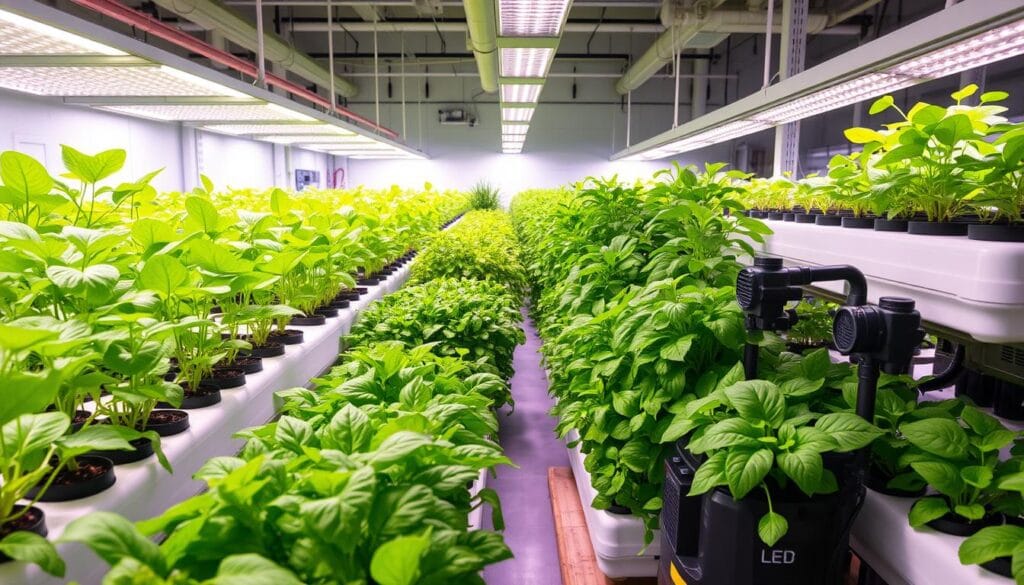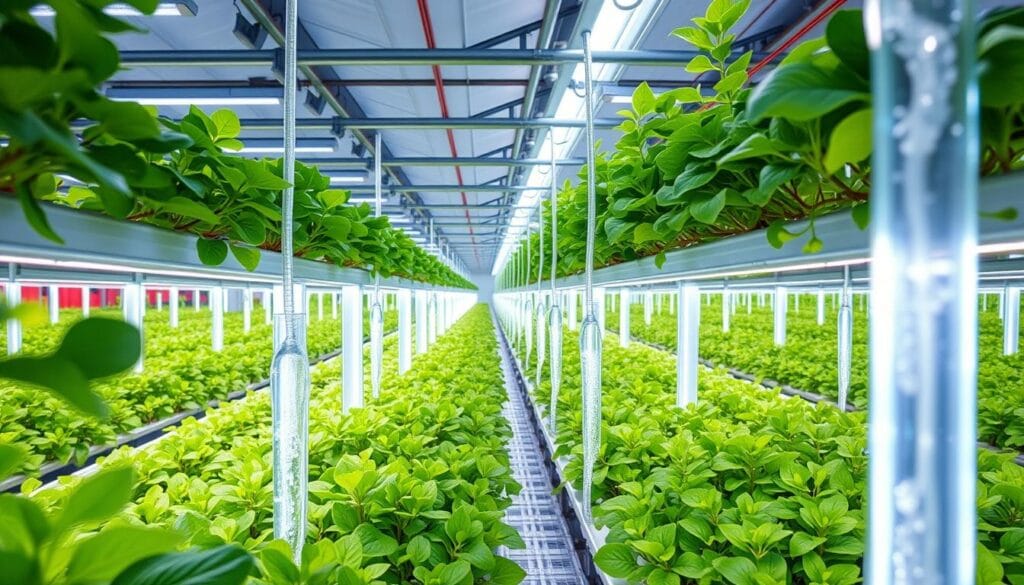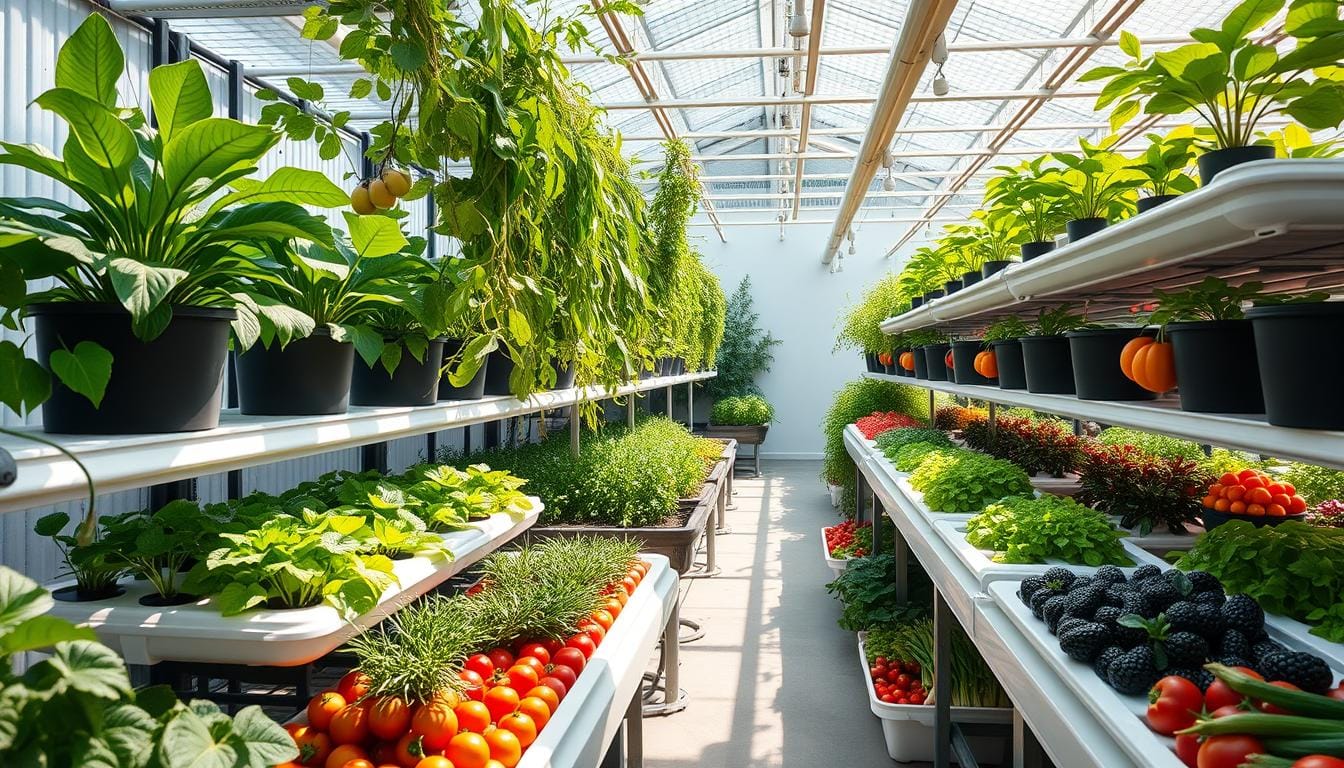Investment Opportunities in Hydroponics: A Game-Changer in Sustainable Food Production.
Hydroponics is revolutionizing sustainable food production. Pioneered by Dr. W. F. Gericke in 1937, this innovative method enables us to grow crops without soil, breaking traditional agricultural boundaries and paving the way for indoor farming.
Are you considering starting a business or exploring investment opportunities in hydroponics? This guide is your roadmap. We’ll delve into the fundamentals of hydroponics, analyze market trends, and identify lucrative investment opportunities. Whether it’s large-scale farms or urban gardening, the possibilities in this booming sector are vast.
Key Takeaways
- Hydroponics is a green and smart way to farm, controlling nutrients, water, and environment.
- The hydroponic market is growing fast, thanks to cities, climate change, and the need for fresh, safe food.
- There are many ways to invest in hydroponics, from big farms to city gardens and tech solutions.
- It’s key to plan your money, understand risks, and follow rules for a good hydroponic investment.
- Good marketing and sales can make your hydroponic farm more profitable and grow bigger.
Understanding the Fundamentals of Hydroponic Agriculture
Hydroponic agriculture is a new way to grow food without soil. It’s becoming popular because it’s good for the planet and efficient. Plants get what they need from a nutrient-rich solution, not soil.
Basic Principles of Soilless Cultivation
Hydroponic farming means growing plants without soil. Plants use media like rockwool or coconut fiber. They get nutrients from water, not soil.
This method uses less land and water. It also lets farmers grow food all year, even in cities.
Key Components of Hydroponic Systems
Hydroponic systems have many parts. These include growing areas, nutrient tanks, pumps, and lights. The nutrient solution gives plants what they need to grow.
Environmental Benefits and Sustainability Aspects
Hydroponic farming is good for the environment. It consumes significantly less water compared to traditional farming methods. It also means no pesticides are needed.
It’s a smart choice for the future of food. The demand for soilless crop production and sustainable food production investments is growing. Hydroponic farming is leading the way.
Current Market Analysis and Growth Projections
The global hydroponic farming investment opportunities are growing fast. This is because people want food that’s locally sourced and sustainable. They care about the environment, so they’re looking for ways to grow food all year round.
Reports show the hydroponics market will hit USD 17.3 billion by 2024. It’s expected to jump to USD 66.6 billion by 2033, growing at 16.2% annually. In the U.S., the market is set to reach USD 15.1 billion by 2033, growing at 15.2% each year.
The market breaks down into several areas. For example, aggregate hydroponic systems are expected to lead, making up 56.4% of the market in 2024. This is because they’re simple, affordable, and versatile. Vegetables will also dominate, holding the largest share in 2024.
| Market Segment | Projected Market Share (2024) |
|---|---|
| Aggregate Hydroponic Systems | 56.4% |
| Vegetable Crops | Highest Market Share |
| Crop Area Above 50,000 sq. ft. | 49.0% |
| Commercial Growers | Largest End-User Segment |
| Asia Pacific Region | 38.2% Market Share |
| North America Region | 29.1% Market Share |
The Asia Pacific region will lead the market, with a 38.2% share in 2024. This is due to fast urban growth, population increase, and support for green farming. North America will follow, with a 29.1% share by 2024.
The rise in hydroponics shows indoor agriculture investments and vertical farming ventures are becoming more popular. They offer sustainable ways to grow food. As people keep choosing eco-friendly food, the hydroponic farming investment opportunities will grow even more.
Exploring Investment Opportunities in Hydroponics
The world of hydroponics is full of investment chances for all kinds of investors. You can look into big commercial farms, urban projects, or the latest in hydroponic tech. Each option in the hydroponics field has its own appeal for those who know where to look.
Commercial Scale Operations
Big hydroponic farms aim to produce a lot of food for stores and wholesalers. They use special farming methods to grow more food with less water and land. Thanks to new tech and automation, these farms can make a lot of money, often more than farms that use soil.
Urban Farming Ventures
As cities grow, so does the need for fresh food. Hydroponics, especially vertical farming, is a smart way to use city space. These farms provide local, green food, making them a good choice for investors.
Technology-Driven Solutions
New tech is changing hydroponics, offering new ways to invest. Things like smart watering systems, AI for climate control, and special lights for plants are leading the way. These innovations help make hydroponics more efficient and productive.
Whether you’re interested in big farms, city projects, or the latest tech, hydroponics has something for everyone. By looking closely at the market and understanding what makes each option work, investors can find great opportunities in this growing field.
| Investment Opportunity | Key Advantages | Potential Challenges |
|---|---|---|
| Commercial Scale Hydroponic Farms |
|
|
| Urban Farming Ventures |
|
|
| Technology-Driven Hydroponic Solutions |
|
|
“Hydroponics uses up to 90% less water than traditional soil-based farming, offering a highly sustainable solution for the future of agriculture.”
Types of Hydroponic Systems and Their Investment Potential
Hydroponic farming offers many investment chances. Each system has its own benefits and fits different needs and sizes. Knowing what each system offers helps investors choose wisely when looking at hydroponic farming investment opportunities.
The Nutrient Film Technique (NFT) is popular. It uses a constant flow of nutrient-rich water over the roots. This is great for soilless crop production in small spaces and vertical farms, making it good for urban precision agriculture funding opportunities.
The Deep Water Culture (DWC) keeps roots in a nutrient-rich water solution. This gives plants a steady supply of oxygen and nutrients. It’s best for big commercial farms because it helps plants grow more.
- Ebb and Flow systems use flooding and draining cycles to give plants better aeration and nutrients. They work well for many crops.
- Drip systems control nutrient delivery with a network of emitters. They’re efficient for big hydroponic farms.
- Wick systems are simple and good for small setups. They fit a wide range of budgets and needs.
Each hydroponic system has its own investment points to consider. These include setup costs, ongoing expenses, and potential earnings. By looking at each system’s features, scalability, and markets, investors can find the best opportunities.
| Hydroponic System | Characteristics | Investment Potential |
|---|---|---|
| Nutrient Film Technique (NFT) | Suitable for small spaces, vertical farming, and urban settings. Requires continuous power supply and is vulnerable to system failures. | Attractive for precision agriculture funding opportunities in urban and controlled environments, but higher initial investment for infrastructure and equipment. |
| Deep Water Culture (DWC) | Ideal for larger commercial operations, offering enhanced growth and yield potential. Requires careful oxygenation to prevent root rot. | Suitable for soilless crop production in large-scale commercial farms, with higher initial setup costs but potential for greater returns. |
| Ebb and Flow | Promotes superior aeration and nutrient delivery through periodic flooding and draining cycles, suitable for a wide range of crops. | Flexible system with moderate initial investment, catering to both small-scale and commercial hydroponic farming investment opportunities. |
| Drip System | Precise control over nutrient delivery, efficient for larger hydroponic farms. Requires regular maintenance to prevent clogging in emitters. | Appealing for large-scale commercial operations seeking precision agriculture funding opportunities, with higher setup costs but potential for enhanced productivity. |
| Wick System | Simple design, suitable for small-scale hobby or educational setups. Limited in scale and growth potential compared to other systems. | Ideal for beginners or small-scale investors exploring entry-level hydroponic farming investment opportunities with a lower financial commitment. |

Investors looking into hydroponic farming investment opportunities need to understand the different systems. Knowing the pros and cons of each helps make smart choices. By looking at costs, expenses, and returns, investors can find the best soilless crop production projects. This way, they can take advantage of the growing demand for green and efficient farming.
Financial Planning and Cost Analysis
Investing in hydroponic farming needs careful financial planning. You must understand all costs involved. This includes the initial setup and ongoing expenses for these sustainable food investments.
Initial Setup Costs
The cost to start a hydroponic system varies a lot. Wick and Deep Water Culture systems are cheaper. But, Aeroponics and advanced Drip systems cost more. You’ll need growing trays, nutrient systems, and climate control equipment.
Operating Expenses
Hydroponic farming has ongoing costs like nutrients, electricity, water, and labor. Keeping the nutrient solution balanced is key for plant growth. Energy for lighting and climate control adds to costs. Also, skilled labor is needed to keep the system running.
Return on Investment Calculations
To figure out the ROI of hydroponic farming, you need to look at several things. These include crop yield, market prices, and how well the system works. Hydroponics often gives higher yields than traditional farming. By looking at these factors, investors can see if their investment will pay off in the long run.
| Cost Estimate | Range |
|---|---|
| Initial Setup Costs (One-Acre Commercial Farm) | ₹1.4 crore to ₹2 crore |
| Monthly Electricity Costs | ₹40,000 to ₹50,000 |
| Monthly Labor Costs | ₹60,000 to ₹80,000 |
| Monthly Nutrient and Growing Media Costs | ₹20,000 to ₹30,000 |
| Annual Crop Yield (Lettuce) | 300 to 400 tonnes |
| Estimated Return on Investment (ROI) | 20% to 30% annually |
Good financial planning and cost analysis are key for hydroponic farming success. Knowing the setup costs, ongoing expenses, and potential returns helps investors make smart choices. This way, they can make their hydroponic farming investments work well.
Risk Assessment and Mitigation Strategies
Entering the world of controlled environment agriculture and hydroponic farming offers great chances, but it also has risks. As an investor looking into precision agriculture funding opportunities and hydroponic farming investment opportunities, knowing and tackling these challenges is key.
One big risk in hydroponic farming is system failures, which can cause huge crop losses. To avoid this, setting up redundant systems and backup plans is vital. This ensures your farm keeps running even when there are power outages, water issues, or equipment problems. Keeping your systems in top shape through regular checks and monitoring is also crucial.
Pests are another big risk in hydroponic systems. To fight this, strict pest management plans, using biological controls, and keeping everything clean are essential. Growing different crops can also help avoid big losses if one crop gets hit by pests or diseases.
Changes in the market and what consumers want can also be risky. Doing deep market research, having many ways to sell your products, and being ready to change with trends can help. Keeping an eye on nutrient levels, pH, and plant health is also important. This ensures your crops are the best they can be, making your hydroponic farm more profitable.
| Risk Factor | Mitigation Strategies |
|---|---|
| System Failures |
|
| Pest Infestations |
|
| Market Fluctuations |
|
By tackling these risks early and using good strategies to avoid them, you can confidently move forward in hydroponic farming. This way, you can make the most of your controlled environment agriculture investments for lasting success and profit.

Legal Requirements and Regulatory Compliance
Investing in hydroponic farming needs you to know a lot about laws and rules. It’s key to understand the licenses, permits, food safety, and environmental rules. This ensures your farm does well and follows the law.
Licensing and Permits
To start a hydroponic farm, you need many licenses and permits. You’ll need a Business License to run your farm, an Agricultural Permit for farming, and Environmental Permits for water and waste. These rules help protect the environment and your farm.
Talking to your local agriculture department is a good first step. They can tell you what laws you must follow. Not following these laws can lead to big fines or even closing your farm.
Food Safety Standards
It’s important to follow food safety rules when investing in hydroponic farming. You must meet Good Agricultural Practices (GAP) and Hazard Analysis Critical Control Point (HACCP) standards. These ensure your food is safe and traceable, which is important for selling it.
Environmental Regulations
Hydroponic farming is good for the environment but still has rules to follow. There are limits on water, waste, and energy use. Following these rules helps protect the environment and keeps your farm legal.
By understanding and following these laws, you can make your hydroponic farm successful. It will thrive in the controlled environment agriculture and sustainable food production investments fields.
Marketing Strategies and Distribution Channels
The hydroponic farming industry is booming. To make the most money, you need to find the best ways to market and sell your products. Focus on local, sustainable, and fresh produce to attract eco-friendly shoppers.
Try selling directly to consumers, at farmers markets, or to local restaurants and stores. Building a strong brand and using social media can help you get noticed. Also, team up with chefs and food providers to reach more people.
| Company | Market Share | Revenues | Profits | Profit Margin |
|---|---|---|---|---|
| NatureSweet Ltd. | 60.8% | $12.4 million | $2.0 million | 2.0% |
| Houweling’s Tomatoes | 25.3% | $6.1 million | $2.4 million | 2.4% |
| Village Farms International Inc. | 10.2% | $2.4 million | $2.3 million | 2.3% |
The table shows top players in hydroponic farming. It shows the chance for urban farming projects and sustainable food production investments to grow. By using hydroponic farming investment opportunities, you can succeed in this fast-changing field.
“Hydroponics has rapidly gained popularity in recent years due to its numerous advantages over traditional soil-based farming, including higher crop yields, efficient water use, and the flexibility to grow in any climate or location.”
To stay ahead, keep up with new trends and tech in hydroponic farming. Go to conferences, workshops, and events to learn and find new chances for growth.
Conclusion
Hydroponic farming offers a bright future for sustainable agriculture. The need for fresh, local, and green food is rising. Hydroponics can save water, cut down on pesticides, and grow more food in less space.
Thinking about starting a big hydroponic farm, a small urban project, or a tech-based solution? The growth and profit potential is huge. Learning about soilless growing, hydroponic systems, and the financial and legal sides can help you succeed.
The market for hydroponic and aquaponic farming is booming, with a 15.78% growth rate expected by 2030. By focusing on the environment, productivity, and tech, your investment can help meet the demand for green food. This could secure your spot in the future of farming.

